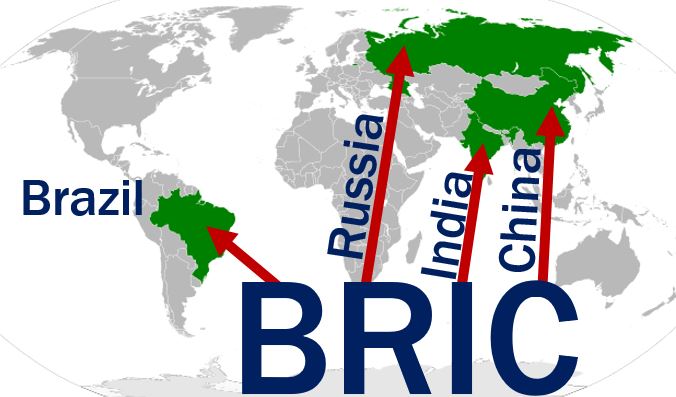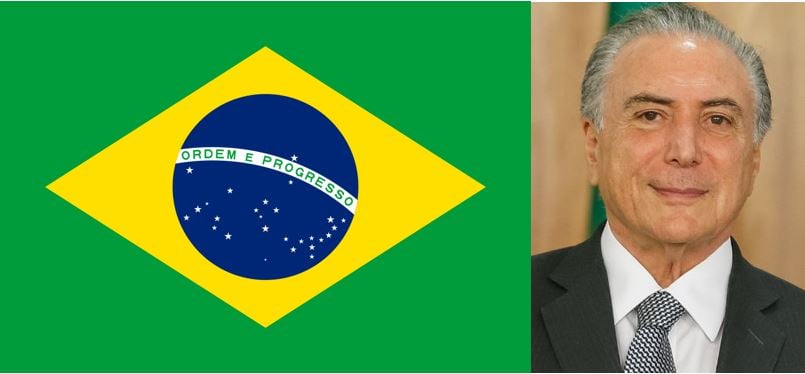What is BRIC? What does BRIC stand for?
BRIC is an acronym for ‘Brazil, Russia, India, and China.’ Economists once saw the four countries as the giant economies of the future. They are all large countries geographically which also have large populations. During the first years of this century, the BRIC countries’ economies were growing rapidly.
Unfortunately, this all ended when the global financial crisis hit in 2007/8. Since then, Brazil and Russia’s economies have shrunk. Even the economies of China and India have been expanding more slowly since the financial crisis than before.
In 2003, Goldman Sachs issued a report which made a prediction for 2050. The report forecast that the four BRIC economies would be wealthier than most of the current major economic powers. In fact, everybody pointed to BRIC as the nations that would soon become advanced economies.

BRIC countries account for over 40% of the world’s population. Economists once predicted their combined GDP would be massive by 2050. In fact, they thought BRIC’s combined GDP would exceed those of the US and EU combined.
BRIC countries are among the most powerful countries in the world.
BRIC countries
Brazil

Brazil is by far the largest economy in South America. The country’s agricultural, manufacturing, and mining sectors account for most of Brazil’s economy.
After the turn of the century, the country enjoyed impressive economic growth. Recently, however, serious problems have emerged, including the Petrobras scandal.
Population: 207.7 million (2016 estimate)
Population growth rate: 0.83 percent
Labor force: 105.7 million (2012 estimate)
GDP (PPP): $2.394 trillion (2012 estimate)
GDP – real growth rate: 0.9 percent (2012), 2.7 percent (2011), and 7.5 percent (2010)
Exports: $242.6 billion (2012 estimate)
Imports: $223.2 billion (2012 estimate)
External debt: $438.9 billion (31 December 2012 estimate)
Public debt: 58.8% of GDP (2012 estimate)
Defense budget: 1.3 percent of GDP (2012)
Russia

After years of communism, the Russian Federation is no longer an isolated nation. The country has drifted from a centralized economy to a market-based economy with a global vision.
Since the first half of 2014, Russia’s economy has slowed down significantly. The economic slowdown is mainly due to a fall in oil prices. Economic sanctions imposed by the US and its allies have also hurt GDP growth. Furthermore, rampant corruption has become an ever-growing problem.
Population: 142,500,482 (July 2013 estimate)
Population growth rate: -0.02% (2013 estimate)
Labor force: 75.68 million (2012 estimate)
GDP (PPP): $2.555 trillion (2012 estimate)
GDP – real growth rate: 3.4 percent (2012), 4.3 percent (2011), and 4.5 percent (2010).
Exports: $528 billion (2012 estimate)
Imports: $335.7 billion (2012 estimate)
External debt: $631.8 billion (31 December 2012 estimate)
Public debt: 58.8% of GDP (2012 estimate)
Defense budget: 3.9 percent of GDP (2012)
India

A little over fifty percent of India’s labor force is in the agricultural sector. However, the country’s main source of economic growth comes from services. In fact, services make up almost 66 percent of the country’s total output.
According to Fortune magazine columnist Ian Bremmer “Change has come to India, the lone BRIC country that’s worth holding on to.”
Population: 1,220,800,359 (July 2013 estimate)
Population growth rate: 1.28% (2013 estimate)
Labor force: 482.3 million (2012 estimate)
GDP (PPP): $4.761 trillion (2012 estimate)
GDP – real growth rate: 6.5 percent (2012), 7.7 percent (2011), and 11.2 percent (2010).
Exports: $301.9 billion (2012 estimate)
Imports: $503.5 billion (2012 estimate)
External debt: $378.9 billion (31 December 2012 estimate)
Public debt: 51.7% of GDP (2012 estimate)
Defense budget: 1.8 percent of GDP (2012)
China

China became the world’s greatest exporter in 2010. After years of a very centralized economy, China is beginning to adopt a much more capitalist, free-market system.
However, over the past few years, GDP growth has slowed down. There is concern about the financial health of many Chinese banks. Even so, despite the recent slowdown, many predict that it won’t be long before China’s GDP overtakes the US’.
Population: 1,349,585,838 (July 2013 estimate)
Population growth rate: 0.46 percent (2013 estimate)
Labor force: 798.5 million (2012 estimate)
GDP (PPP): $12.61 trillion (2012 estimate)
GDP – real growth rate: 7.8 percent (2012), 9.3 percent (2011), and 10.4 percent (2010).
Exports: $1.971 trillion (2012 estimate)
Imports: $1.653 billion (2012 estimate)
External debt: $728.9 billion (31 December 2012 estimate)
Public debt: 31.7% of GDP (2012 estimate)
Defense budget: 2.6 percent of GDP (2012)
The future of BRIC countries
The Economist stated that a great deceleration could occur. The economies of China and India grew at double-digit rates prior to the financial crisis.
During the second decade of this century, on the other hand, GDP growth rates have been in single digits.
Unfortunately, Brazil’s and Russia’s economies have failed miserably over the past few years. In fact, the two economies are smaller today than four years ago.

